When alumni Denise Mincey-Mills, Antonio Junior, and Phyllis Tyler—co-chairs of the Black Alumni Society’s First Black Graduates Project Committee—described the four years they devoted to sifting through Ibis yearbooks and University Libraries’ archives to learn more about the struggles and successes of UM’s black graduates of the 1960s and 1970s, they called it “uncaging history.”
That history sprang to life the weekend of February 24 during UTrailblazers, a celebration that brought hundreds of people to campus to honor those who blazed a trail of diversity and inclusion during the first two decades of racial integration at UM. The event kicked off on Friday with a campus bus tour and visit to the Richter Library to view the We Were Pioneers exhibit, which ran through the month of February and showcased archival materials detailing the early years of black life on campus.
In his lecture at the library, Professor of History Donald Spivey discussed key elements of Miami’s civil rights movement and urged the audience to “take the baton” the UTrailblazers handed to the UM community, “accept the responsibility, and run with it.” Adding their thoughts were three of the UTrailblazers recognized in the exhibit and throughout the weekend: Ray Bellamy, the first black recipient of a football scholarship; Kim Sands, the first black female scholarship recipient; and Whittington Johnson, the first black faculty member.
“January 31, 1961, was a day of immense historic importance,” UM President Julio Frenk said at the Opening Ceremony in the Newman Alumni Center that followed the library presentation. “That afternoon, the University of Miami’s Board of Trustees—24 members in attendance—23 men, one woman, all white—unanimously voted to, and I quote, ‘accept any qualified student…regardless of race, creed, or color.’ In that moment, this University became a great institution.”
The Opening Ceremony continued with an alumni-student forum that Bellamy moderated, student dance and spoken word performances, and a keynote address by alumnus Harold Long Jr., the founder of United Black Students who orchestrated a 1968 sit-in at then-President Henry King Stanford’s office to demand more resources for African-American students, faculty, and curriculum. Also in attendance were former Vice President for Student Affairs William Butler and former administrator Anna Price, who were among 16 faculty members and administrators recognized for their trailblazing efforts.
On Saturday, more than 400 people attended the UTrailblazers Gala at the Shalala Student Center, including some alumni who had not been back to campus in decades but are now eager to reconnect with their alma mater. Patricia Roberts, a double alumna of the School of Education and Human Development who lives in Miami but hadn’t visited since earning her master’s degree in 1973, was among them. “Oh, I’ll be back,” she said, marveling at the beauty of the campus that has changed so much.
Roberts’ reflections about her student experiences and as the University’s first black cheerleader are living, along with the oral histories of 45 other UTrailblazers, in video testimonies captured by the UM Alumni Association on Friday and Saturday. The videos are part of the University’s continued effort to not only “uncage” but also to cultivate additional insight on its past.
“Some of you went here when you were afraid to walk to class,” said actor and comedian Finesse Mitchell, a 1995 School of Communication alumnus who was the gala’s master of ceremonies. “Look at us now; we’ve taken over the ballroom of the best building on campus!”
Executive Vice President and Provost Thomas J. LeBlanc welcomed the gala crowd and assisted the First Black Graduates Project co-chairs in an on-stage recognition of 13 “Top of the Class” honorees, including artist and 1976 alumnus C.J. Latimore, who donated a commemorative collage print he created to all fellow honorees. UM Trustee H.T. Smith introduced keynote speaker George Knox, a fellow Top of the Class honoree and fellow 1973 School of Law graduate, with a memory of how Knox typically responded to any negativity he encountered on campus.
“George would tell them, ‘Affirmative action didn’t pass those law school exams; that was us... Affirmative action didn’t have a 100 percent passing rate on the Florida Bar the first time; that was us,’” Smith said.
In an effort to continue blazing trails of opportunity and inclusion at the University, donors to the First Black Graduates Projects Endowed Scholarship are building a fund that will, in perpetuity, award $2,500 to two black students per year. Alumnus Johnny C. Taylor Jr. announced at the gala that the fund has reached more than $91,000, in addition to his own $25,000 pledge.
The scholarship is a bridge to the mission of the early UTrailblazers, who sought to build permanent pathways to a UM education for qualified black students, regardless of their financial abilities. It is the essence of the phrase invoked throughout the festivities: “Blazing the trail, building the dream.”
And as Knox acknowledged, the dream has become an ever-widening, two-way street.
“The University of Miami helped to educate us and mold us,” Knox said. “We and the University were enriched by the experience. Now we are free to say ‘We love you, University of Miami,’ and we know you love us back.”
Read more about the University’s First Black Graduates Project.
View the gala program, which contains a listing of black graduates from the 1960s and 1970s.

